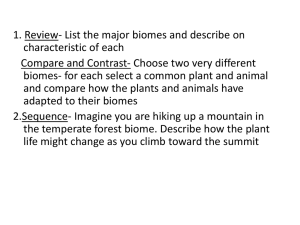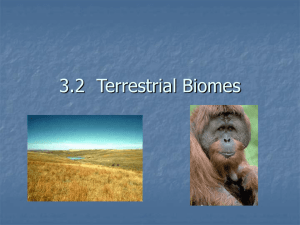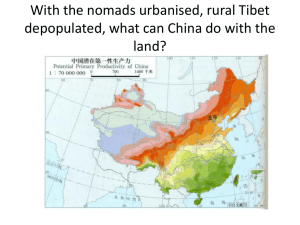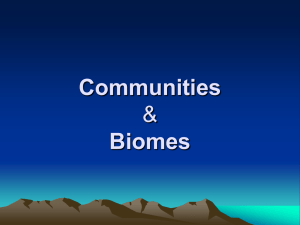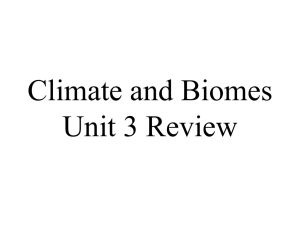Ecosystems and Communities
advertisement
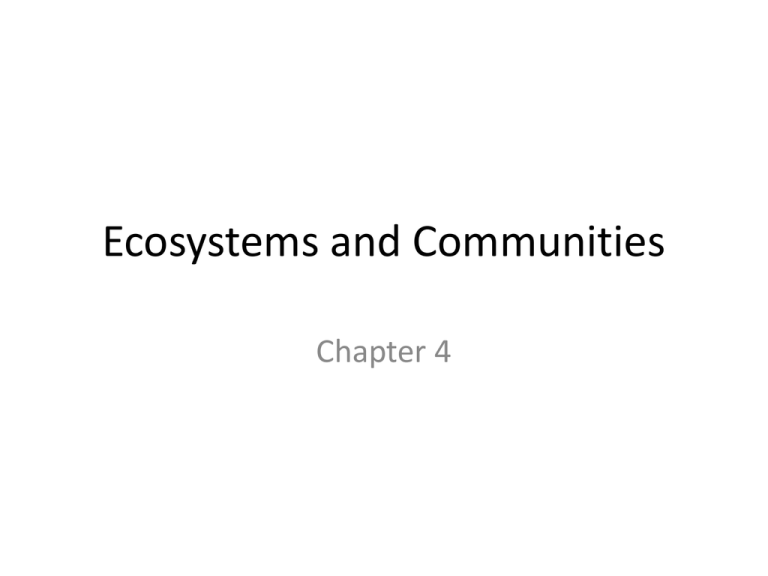
Ecosystems and Communities Chapter 4 Weather Day-to-day conditions of Earth’s atmosphere. Climate Average conditions over long periods. Regional climate Year-after-year patterns of temperature and precipitation Microclimates Environmental conditions that can vary over small distances e.g. south- facing side of trees and buildings receive more sunlight, and are often warmer and drier than north-facing sides. Factors That Affect Climate • Solar energy trapped in the biosphere – Greenhouse Effect • Latitude • Transport of Heat by winds • Ocean Currents Solar Energy • Main force that affects climateSolar Energy (sunlight) • Reflected back into space • Absorbed • Converted into heat Earth’s average temperature Balance b/w heat that stays in biosphere and heat lost to space Balance controlled by concentrations of: • Carbon Dioxide • Methane • Water Vapor Greenhouse Gases-Function like glass in a greenhouse; allow visible light to enter but trap heat. Greenhouse Effect Process in which gases trap sunlight energy in Earth’s atmosphere as heat. Heat trapped-temps to rise Heat escapes-temps cool Latitude A measure of relative position north or south on the Earth's surface, measured in degrees from the equator, which has a latitude of 0°, with the poles having a latitude of 90° north and south. www.dictionary .com Solar Energy • Equator-Sun almost directly overhead at noon all year long-generally warm • Poles-Receive less intense solar energy, less heat-cooler • Differences in heat distribution create climate zones (tropical, temperate, and polar). Tropic Zone • Equator • B/w 23.5° North and 23.5 ° South Latitudes • Direct sunlight all year Temperate Zone • B/w 23.5°and 66.5 ° North and South Latitudes Polar Zone • B/w 66.5°and 90 ° North and South Latitudes Climates • Varied amounts of solar energy at different times of year because of Earth’s axis is tilted • As earth revolves around sun, solar radiation strikes different regions at angles that vary from summer to winter. • Winter-sun lower in sky; shorter days and solar energy less. Heat transport in the biosphere • Unequal distribution of heat across globe create winds and ocean currents; transport heat and moisture Creation of winds • Warm air less dense and rises • Cool air more dense and sinks • Air heated by warm area of Earth’s Surface (equator) rises. • Warm air rises-spreads north and south, losing heat along way. Cool air sinks Creation of Winds • (Same time) Cooler regions (poles)-chilled air sinks towards earth surface; pushing air at surface outward • Air warms as travels over surface; as warms it rises. • Upward and downward movement of air creates winds. Winds • • • • Winds transport heat Warm air rises Cool air sinks Earth’s rotation causes winds to blow generally from • west to east-temperate zones • East to west over tropics and the poles Heating and Cooling in Oceans • Surface water pushed by winds. • Currents carry lots of heat • Warm surface currents add moisture and heat to air; Cool surface currents cool airaffecting climate and weather of nearby land. Currents Deep ocean currents caused by cold water near the poles sink and flowing along ocean floor. Water rises in warmer regions through a process called upwelling. Niches and Community Interactions Species Success • Each species has a range of conditions under which it can grow and reproduce. • Conditions define where and how an organism lives. Tolerance Species ability to survive and reproduce under a range of environmental circumstances. (RANGE) Tolerance Graphs Shows the response of an organism to different values of a single environmental variable Tolerance Graphs Zone of Tolerance • Optimal Range (center) organisms most likely to be most abundant • Physiological stress zone (edges of curve) organisms stressed and numbers decline – Expend more energy to maintain homeostasis – Less energy available for growth and reproduction Zone of Intolerance • Outside tolerance zone; No organisms Intolerance Zone Habitat • General place where an organism lives. • Determined by species tolerance for specific environmental conditions Niche (organisms occupation) The range of physical and biological conditions in which a species lives and the ways the species obtains what it needs to survive and reproduce. Aspect = parts Two aspects of an organism’s niche • Physical • Biological Niches • Resources – Necessity of life such as food, water, light, nutrients or space. – Plants- sunlight, water and soil nutrients – Animals- nesting, space, shelter, food, places to feed • Physical Aspects – Abiotic factors it requires for survival. E.g amphibians lose and absorb water through skin::must live in moist places. • Biological – Biotic factors required for survival. E.g. when/how reproduces, food it eats, way obtains food. Competition • Community-more than one kind of organism attempting to use various essential resources. • Same resources at same time and place = competition • Intraspecific competition-same species competing • Interspecific competition- competing b/w different species. What do you think these two males are fighting over? Direct Competition • Competition = almost always a winner and loser (losing species dies out) Competitive Exclusion Principle States no two species can occupy exactly the same niche in exactly the same habitat at exactly the same time. Species with same niche One species will be better at competing for limited resources and will eventually exclude other species. Dividing Resources • Instead of competing resources divided • By causing species to divide resources, competition helps determine the number and kinds of species in a community and the niche each species occupies. What would happen if two of the warlber species tried to occupy the same niche in the same tree at the same time? Predation, Herbivory, and Keystone Species Predation An interaction in which one animal (the predator) captures and feeds on another animal (the prey) Predation • Predators can affect prey population in a community • Can determine the places prey can live and feed. – E.g. birds can play important role in regulating mouse population sizes Herbivore-Plant Relationship An interaction in which one animal (herbivore) feeds on producers (plants) is called HERBIVORY Herbivores • Affect size and distribution of plant populations in a community • Determine the places that certain plants can survive and grow • E.g- Very dense populations of white-tailed deer are eliminating their favorite food plants across US. Keystone Species A change in a single species that can cause a dramatic change in the structure of a community Keystone Species • E.g.- Sea otters devour large amounts of sea urchins; Urchins are herbivores that eat kelp (giant algae that grows undersea “forests”. • Sea otters almost eliminated by hunting; urchins population increased; devoured kelp. • Other organisms also disappeared. • Sea otters went on endangered species, populations recovered Symbioses Any relationship in which two species live closely together (Three main classes: mutualism, parasitism, and commensalism) Mutualism • Relationship in which both species benefit • E.g. – Sea anemone (sting functions-capture prey and protect anemone from predation) and clownfish (immune to stings) Sea anemone-offers shelter; clownfish darts out and chases other fish away (protects for preditors) Parasitism A relationship in which one organism lives inside or on another organisms and harms it. parasites • E.g. Tapeworms live in the intestines of mammals; absorb large amounts of hosts food • E.g. Fleas, ticks and lice live on mammals feeding on blood and skin. • Parasites obtains all or part of its nutritional needs • Parasites weaken but generally do not kill hosts. Commensalism Relationship in which one organism benefits and another organism is neither harmed or helped Commensalism • E.g. Grey whale and barnacles– Grey whale not harmed and no benefits – Barnacles- benefit from flow of water from moving whale that provides food Sloth and lichen, what type of relationship? Succession Succedere (latin) “to come after” Ecological Succession Ecosystems change over time, especially after disturbances, as some species die out and new species move in. Primary Succession Succession that occurs in an area in which no trace of a previous community is present. (newly exposed surfaces) Primary Succession • Must create soil • Occurs over a long period of time Pioneer Species 1st species to colonize barren areasnamed after rugged human pioneers who first settled the wilderness. Eg. Lichen (on rock) Lichen • Lichen (mutualistic-algae and fungus) converts nitrogen from atmosphere to into useful nitrogen for other organisms • break down rock • Add organic material to form soil Secondary Succession Type of succession that occurs in a n area that was only partially destroyed by disturbances. Secondary Succession • Soil already established :: more rapid growth • E.g of causes-wildfire, hurricane, or other natural disturbance. • Note-Fires are necessary for some species survival; certain trees need them for seeds to germinate. • Could have different pioneer species Why Succession Occurs? • Every organism changes the environment it lives in. • As one species alters its environment; other species find it easier to find resources and survive. • Lichen-add organic matter, form soil- other plants can colonize and grow; more species move in and further change environment; Over time, more and more species find niches and survive. Climax Communities Traditional Definition/view point An ecological community in which populations of plants or animals remain stable and exist in balance with each other and their environment. A climax community is the final stage of succession, remaining relatively unchanged until destroyed by an event such as fire or human interference. www.dictionary.com Modern Idea of a Climax Community • Succession doesn’t always follow same path • Often reproduces original climax community. • Are not always uniform and stable (disturbed so often) Human-Caused Disturbances • E.g - Farming • Ecosystems may or may not recover from extensive human-caused disturbances • E.g farming a Tropical rain forests can change microclimate and soil enough to prevent regrowth of original community. Studying patterns of succession • compare different cases • look for similarities and differences • Eg. Mount Saint Helens and Krakatau (volcanoes) – Both places primary succession proceeded through predictable stages – Hardy pioneer species helped stabilize loose volcanic debris – Confirmed early stages of primary succession are slow and that chance can play a large role in determining which species colonize at different times. THINK ABOUT IT – Why does the character of biological communities vary from one place to another? – Why, for example, do temperate rain forests grow in the Pacific Northwest while areas to the east of the Rocky Mountains are much drier? – How do similar conditions shape ecosystems elsewhere? The Major Biomes Biomes are described in terms of – abiotic factors like climate and soil type – biotic factors like plant and animal life. Global Climate – Latitude and the heat transported by winds are two factors that affect global climate. – Area’s proximity to an ocean or mountain range Regional Climates – In Oregon, cold currents that flow from north to south have the effect of making summers in the region cool relative to other places at the same latitude. Regional Climates – Oregon borders the Pacific Ocean, and moist air carried by winds traveling west to east is pushed upward when it hits the Rocky Mountains. – This air expands and cools, causing the moisture in the air to condense and form clouds. Regional Climates – The clouds drop rain or snow, mainly on the upwind side of the mountains. – As the air sinks on the downwind side of the mountain, it expands, warms, and absorbs moisture. – As a result, west and east Oregon have very different regional climates, and different climates mean different plant and animal communities. Defining Biomes – Ecologists classify Earth’s terrestrial ecosystems into at least ten different groups of regional climate communities called biomes. – Biomes are described in terms of abiotic factors like climate and soil type, and biotic factors like plant and animal life. – Major biomes include • • • • • • • • • • tropical rain forest tropical dry forest tropical grassland/savanna/shrubland Desert temperate grassland temperate woodland and shrubland temperate forest northwestern coniferous forest boreal forest tundra. Defining Biomes – The map shows the locations of the major biomes. Defining Biomes – Each biome is associated with seasonal patterns of temperature and precipitation that can be summarized in a graph called a climate diagram. – A climate diagram shows the average temperature and precipitation at a given location during each month of the year. On this climate diagram, temperature is plotted as a red line, and precipitation is shown as vertical blue bars. Defining Biomes – Organisms within each biome can be characterized by adaptations that enable them to live and reproduce successfully in the environment. – However, even within a defined biome, there is often considerable variation among plant and animal communities. – These variations can be caused by differences in exposure, elevation, or local soil conditions. – Local conditions also can change over time because of human activity or because of community interactions. TROPICAL RAIN FOREST – More species than all the other biomes combined – Rain forests get at least 2 meters of rain a year! TROPICAL RAIN FOREST – Tall trees form a dense, leafy covering called a canopy from 50 to 80 meters above the forest floor. In the shade below the canopy, shorter trees and vines form a layer called the understory. – Organic matter on the forest floor is recycled and reused so quickly that the soil in most tropical rain forests is not very rich in minerals. TROPICAL RAIN FOREST Abiotic Factors: – Rain forests are hot and wet year-round. – They have thin, nutrient-poor soils that are subject to erosion. TROPICAL RAIN FOREST – Biotic Factors – Plant Life – Understory plants compete for sunlight, so most have large leaves that maximize capture of limited light. TROPICAL RAIN FOREST – Tall trees growing in poor shallow soil often have buttress roots for support. TROPICAL RAIN FOREST – Epiphytic plants grow on the branches of tall plants as opposed to soil. This allows the epiphyte to take advantage of available sunlight while obtaining nutrients through its host. TROPICAL RAIN FOREST – Biotic Factors – Animal Life – Animals are active all year – Many animals use camouflage to hide from predators – Some change color to match their surroundings. TROPICAL RAIN FOREST – Biotic Factors – Animal Life – Animals that live in the canopy have adaptations for climbing, jumping, and/or flight. TROPICAL DRY FOREST – Tropical dry forests grow in areas where rainy seasons alternate with dry seasons. – In most places, a short period of rain is followed by a prolonged period of drought. TROPICAL DRY FOREST – Abiotic Factors – Warm year-round, with alternating wet and dry seasons. – Rich soils are subject to erosion. TROPICAL DRY FOREST – Biotic Factors – Plant Life – Adaptations to survive the dry season include seasonal loss of leaves. – A plant that sheds its leaves during a particular season is called deciduous. – – Some plants also have an extra thick waxy layer on their leaves to reduce water loss, or they store water in their tissues. TROPICAL DRY FOREST – Biotic Factors – Animal Life – Many animals reduce their need for water by entering long periods of inactivity called estivation. – Estivation is similar to hibernation, but typically takes place during a dry season. – Other animals, including many birds and primates, move to areas where water is available during the dry season. TROPICAL GRASSLAND/SAVANNA/SHRUBLAND – More seasonal rainfall than deserts but less than tropical dry forests. – Grassy areas are spotted with isolated trees and small groves of trees and shrubs. TROPICAL GRASSLAND/SAVANNA/SHRUBLAND – compacted soils – fairly frequent fires – action of large animals prevent some areas from turning into dry forest. TROPICAL GRASSLAND/SAVANNA/SHRUBLAND Abiotic Factors – Warm, with seasonal rainfall. – Soil is compact-frequent fires set by lightning. TROPICAL GRASSLAND/SAVANNA/SHRUB LAND Biotic Factors – Plant Life – Adaptations include waxy leaf coverings and seasonal leaf loss. TROPICAL GRASSLAND/SAVANNA/SHRUBLAND Biotic Factors – Plant Life – Some grasses have a high silica content that makes them less appetizing to grazing herbivores – Unlike most plants, grasses grow from their bases, not their tips, so they can continue to grow after being grazed. TROPICAL GRASSLAND/SAVANNA/SHRUBLAND Biotic Factors – Animal Life – Many animals migrate during the dry season in search of water. – Some smaller animals burrow and remain dormant during the dry season. DESERT – Less than 25 centimeters of precipitation annually, but otherwise vary greatly, depending on elevation and latitude. – Many deserts undergo extreme daily temperature changes, alternating between hot and cold. DESERT Abiotic Factors – Low precipitation and variable temperatures. – Soils are rich in minerals, but poor in organic material. DESERT Biotic Factors – Plant Life – Many plants, including cacti, store water in their tissues, and minimize leaf surface area to cut down on water loss. Cactus spines are actually modified leaves. DESERT Biotic Factors – Plant Life – Modified photosynthesis in some plants requires leaf pores to open only at night, enabling plants to conserve moisture on hot, dry days. DESERT Biotic Factors – Animal Life – Many desert animals get the water they need from the food they eat. – To avoid the hottest parts of the day, many animals are nocturnal—active only at night. DESERT – Large or elongated ears and other extremities often have many blood vessels close to the surface to help the animal lose body heat and regulate body temperature. TEMPERATE GRASSLAND – Plains and prairies once covered vast areas of the mid-western and central United States. – Periodic fires and heavy grazing by herbivores maintained grassland plants. – Today, most have been converted for agriculture because their soil is so rich in nutrients and is ideal for growing crops. TEMPERATE GRASSLAND – Warm to hot summers and cold winters, with moderate seasonal precipitation. – Soil is fertile and there are occasional fires. TEMPERATE GRASSLAND Biotic Factors – Plant Life – Grassland plants—especially grasses, which grow from their base—are resistant to grazing and fire. TEMPERATE GRASSLAND Biotic Factors – Plant Life – Wind dispersal of seeds is common in this open environment. – Root structure and growth habit of grassland plants help establish and retain deep, rich, fertile topsoil. TEMPERATE GRASSLAND Biotic Factors – Animal Life – Because temperate grasslands are such open, exposed environments, predation is a constant threat for smaller animals. – Camouflage and burrowing are two common protective adaptations. TEMPERATE WOODLAND AND SHRUBLAND – In open woodlands, large areas of grasses and wildflowers are interspersed with oak and other trees. – Communities that are more shrubland than forest are known as chaparral. – Dense low plants that contain flammable oils make fire a constant threat. TEMPERATE WOODLAND AND SHRUBLAND Abiotic Factors – Hot dry summers and cool moist winters. – Thin, nutrient-poor soils and experience periodic fires. TEMPERATE WOODLAND AND SHRUBLAND Biotic Factors – Plant Life – Woodland plants have adapted to drought. – Woody chaparral plants have tough waxy leaves that resist water loss. TEMPERATE WOODLAND AND SHRUBLAND Biotic Factors – Plant Life – Fire resistance is important, although the seeds of some plants need fire to germinate. TEMPERATE WOODLAND AND SHRUBLAND Biotic Factors – Animal Life – Varied diets of grasses, leaves, shrubs, and other vegetation. – In exposed shrubland, some camouflage TEMPERATE FOREST – Mostly deciduous and evergreen coniferous trees. – Coniferous trees, or conifers, produce seedbearing cones – most needle-shaped leaves coated in a waxy substance (reduce water loss) TEMPERATE FOREST – Cold to moderate winters, warm summers – Autumn-shed their leaves – Spring-small plants burst from the ground and flower – Fertile soils (humus-a material formed from decaying leaves and other organic matter) TEMPERATE FOREST TEMPERATE FOREST – Biotic Factors – Plant Life – Deciduous trees drop their leaves and dormant in winter. – Conifers have needlelike leaves TEMPERATE FOREST – Biotic Factors – Animal Life – Changing weather • some animals hibernate • migrate to warmer climates. • camouflaged to escape predation in the winter, when bare trees leave them more exposed. NORTHWESTERN CONIFEROUS FOREST – Mild moist air from the Pacific Ocean influenced by the Rocky Mountains provides abundant rainfall to this biome. NORTHWESTERN CONIFEROUS FOREST – The forest includes • a variety of conifers • flowering trees and shrubs such as dogwood and rhododendron • Moss often covers tree trunks and the forest floor • Because of its lush vegetation, the northwestern coniferous forest is sometimes called a “temperate rain forest.” NORTHWESTERN CONIFEROUS FOREST Abiotic Factors – Experience mild temperatures – Abundant precipitation in fall, winter, and spring. – Summers are cool and dry – Soils are rocky and acidic NORTHWESTERN CONIFEROUS FOREST – Seasonal temperature variation – less diversity in this biome than in tropical rain forests – ample water and nutrients support lush, dense plant growth. NORTHWESTERN CONIFEROUS FOREST – Adaptations that enable plants to obtain sunlight are common. – Trees here are some world’s tallest. Northwestern Coniferous Forest Biotic Factors – Animal Life – Camouflage helps avoid predation – Many animals are browsers—they eat a varied diet—an advantage in an environment where vegetation changes seasonally. BOREAL FOREST – Dense forests of coniferous evergreens along the northern edge of the temperate zone are called boreal forests, or taiga. – Winters are bitterly cold – Summers are mild and long enough to allow the ground to thaw. – Occur mostly in the northern part of the Northern Hemisphere. – The word boreal comes from the Greek word for “north.” BOREAL FOREST Abiotic Factors – Moderate precipitation – High humidity – Soil is acidic and nutrient-poor. BOREAL FOREST Biotic Factors – Plant Life – The conical shape of conifers sheds snow, leaves prevent water loss, making conifers well suited to the boreal forest environment. – Dark green color of most conifers absorbs heat energy. BOREAL FOREST Biotic Factors – Animal Life – Staying warm is the major challenge for boreal forest animals. – Small extremities and extra insulation in the form of fat or downy feathers. – Some migrate to warmer areas in winter. TUNDRA – Characterized by permafrost, a layer of permanently frozen subsoil. – Short cool summer-ground thaws to a depth of a few centimeters and becomes soggy. – In winter, the top layer of soil freezes again. – Thawing and freezing-rips and crushes plant roots (one reason that tundra plants are small and stunted) TUNDRA – Cold temperatures – high winds – short growing season – humus-poor soils-limit plant height. TUNDRA Abiotic Factors – Strong winds and low precipitation. – Summers are short and soggy, and the winters are long, cold, and dark. TUNDRA Abiotic Factors – Permafrost- permanently frozen subsoil. TUNDRA Biotic Factors – Plant Life – By hugging the ground, mosses and other low-growing plants avoid damage from frequent strong winds. – Seed dispersal by wind is common. TUNDRA Biotic Factors – Plant Life – Adapted to growth in poor soil, • E.G. legumes, which have symbiotic bacteria on their roots that fix nitrogen. TUNDRA Biotic Factors – Animal Life – Migrate to avoid the long harsh winters. – Year-round-display adaptations such as natural antifreeze, small extremities that limit heat loss, and a varied diet. Other Land Areas – What areas are not easily classified into a major biome? – Not a typical community of plants and animals – E.g. mountain ranges and polar ice caps Mountain Ranges – All continents and in many biomes. – Temperature, precipitation, exposure to wind, and soil types all change with elevation, and so do organisms. Polar Ice Caps – Polar regions border the tundra and are cold year-round. – Plants are few – Some algae grow on snow and ice. – Rocks and ground are exposed seasonally, mosses and lichens may grow. – Marine mammals, insects, and mites are the typical animals. Polar Ice Caps – In the north, where polar bears live, the Arctic Ocean is covered with sea ice – ice is melting each summer. – In the south, the continent of Antarctica is covered by ice nearly 5 kilometers thick in places. Aquatic Ecosystems Factors that effect aquatic ecosystems • • • • • Water’s depth Temperature Flow Amount of dissolved nutrients Runoff-Distance from the shore Water Depth • Sunlight penetrates only a relatively short distance through water • Photic Zone-sunlit region – photosynthesis can occur – Up to 200 meters in tropics – Phytoplankton-photosynthetic algae – 1st step in many aquatic food webs • Aphotic Zone-Below photic zone; no photosynthesis Benthos Organisms that live on, or in, rocks and sediments on the bottoms of lakes, streams, and oceans-habitat is the benthic zone Benthic Zone • Water is shallow enough for photic zone – Algae and rooted aquatic plants can grown • Below photic zone – Chemosynthetic autotrophs are the only primary producers Temperature and Current • Warmer near equator; colder near poles • Temps vary w/ depth; deepest often colder • Lakes and oceans-Current carry water that is significantly colder or warmer than would be typical for any given latitude, depth, distance from shore Nutrient Availability • Organisms needs substances to live-oxygen, nitrogen, potassium and phosphorus • Type and availability of dissolved substances vary w/I and b/w bodies of water, greatly affect types of organisms that can survive there. Freshwater Ecosystems • 3 categories: River and streams, lakes and ponds, freshwater wetlands. • 3% of Earths surface water • Terrestrial Organisms- Source of drinking water, food and transportation River and Streams creeks, and brooks • Often originate from underground water sources in mountains or hills • Near source-plenty dissolved oxygen; little plant life • Downstream-sediment and plants • Animals depend on terrestrial plants and animals along banks for food. Lakes and ponds • Food webs based on plankton and attached algae and plants. • Plankton-general term for phytoplankton and zooplankton • Water-flows in and out and circulates b/w surface and benthos • Circulation distributes heat, oxygen, and nutrients. Wetlands • Ecosystem in which water either covers the soil or is present at or near the surface for at least part of the year. • Nutrient-rich, highly productive, breeding grounds for many organisms. • Environmental Functions – purify water by filtering pollutants – Prevent flooding by absorbing large amounts of water and slowing releasing it. • Bog, Marsh, Swamp Estuaries • Special wetland-river meets the sea • Mix of fresh and salt water • Effected by rise and fall of tides • Many shallow-sunlight reaches benthos to power photosynthesis • Support great amount of Biomass-although contain few species than freshwater or marine. Estuaries • Spawning and nursery grounds for many ecological/commercially important fish and shellfish (bluefish, bass, shrimp and crabs) • Salt marshes– Temperate conditions – Salt-tolerant grasses above the lowtide line and seagrasses below the water. – One of largest-Chesapeake Bay in Maryland Estuaries • Mangrove Swamps – Tropical estuary – Salt-tolerant trees-collectively mangroves – Largest-Florida’s Everglade National Park Marine Ecosystems • Occupy specific areas w/I the ocean • Ocean zones – Intertidal zone – Coastal zone – Open Ocean Intertidal Zone • Submerged high tide; air and sunlight low tide • Subjected to regular and extreme changes in temps • Battered by waves and currents • Barnacles and seaweed attached to rocks. Coastal Ocean • Low tide mark to outer edge of continental shelf • Water brightly lit • Nutrients from runoff • Highly productive • Kelp forests and coral reefs Open Oceans • Edge of the continental shelf and extends outward • 90 % of world’s ocean • 500 meters (shelf) to 10,000 meters in ocean trenches • Photic and aphotic zones Open Ocean-Photic Zone • Low nutrient levels • Supports only small phytoplankton • Most photosynthesis occurs in top 100 meters Open Ocean-Aphotic Zone • Permanently dark zone; deepest parts of ocean • Food webs based on photic zone or chemosynthetic primary producers • High pressure, frigid temperatures and total darkness • Islands of high productivity • Deep-sea vents, superheated water boils out of cracks
